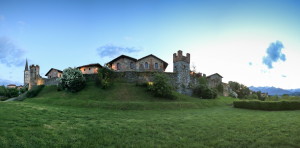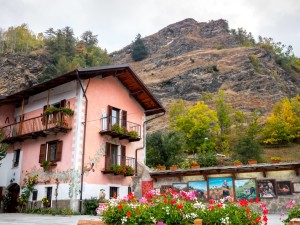
©Bigstock.com
A total area of 25,399.83 km² makes Piedmont Italy’s largest region. It borders two countries (Switzerland to the north, France to the north) and four regions. Beyond its magnificent, even world-renowned cities – particularly the city of arts Turin – you will discover many a beautiful, more remote place that managed to retain its original charm with medieval undertones. The private association “I borghi più belli d’Italia” dedicates itself to supporting and presenting these wonderful spots. Today we take you to three provinces in Piedmont: Alessandria, Biella and the Metropolitan City of Turin.
Province of Alessandria
You can find Alessandria, the region’s third-largest province, in southeast Piedmont. This predominantly mountainous and hilly terrain is known for its numerous rivers and lakes, while the plans in the inland are mostly used for farming. Setting aside the larger towns, like Tortona, Casale Monferrato or Alessandria itself, here are some special places we need to introduce you to.
Cella Monte
This charming small town with just under 500 inhabitants in the UNESCO-protected wine-growing region of Monferrato likely got its name from the wine cellars that were carved into sandstone. You can visit them during a walk of the underground chambers, the so-called Infernòt. Constant temperatures and humidity plus lack of light provide ideal conditions for wine storage. Your walk through Cella Monte leads you past shells embedded in stone. There used to be a large ocean in this area some millions of years ago leaving behind the sandstone with maritime remnants.
Garbagna
The main village of the Val Grue got its name from the Roman emperor and founder Galba. A trip to the castle overlooking the small town (just over 600 inhabitants) is always worth your while. This medieval complex dates back to the 9th century. The sanctuary Santuario della Madonna del Lago is located outside Garbagna. Legend has it that the Virgin Mary appeared to a mute shepherdess in 1341 and gave her the power of speech.
Vho
Vho (approx. 250 inhabitants) actually isn’t a village in its own right but rather a part of Tortona. The view of the surrounding fields and vineyards alone knows to impress. Numerous museums aside, you must check out the church San Salvatore with its astounding marble floors and statues.
Volpedo
A visit to Volpedo (approx. 1,200 inhabitants) truly spoils the palate as the small town is known for growing fruit, for excellent marmalades and potato dumplings. If you’re not hungry, there’s still plenty to see here. The 10th century Romanesque church is lined with frescoes from the school of the Basilio brothers, who were responsible for part of the interior of the Cathedral of Milan. There’s a small museum on the outskirts dedicated to the painter Giuseppe Pellizza da Volpedo. He was born in Volpedo and became famous in Milan.
Province of Biella
Biella is among the country’s youngest provinces. It was only established in 1996 and is mostly surrounded by Turin und Vercelli. Setting aside the old ritual site in Oropa that was declared UNESCO World Heritage as part of Sacri Monti, two particularly charming places await you in the Province of Biella.
Ricetto di Candelo
Ricetto comes from the Latin word “receptum” (shelter, refuge). Ricetto di Candelo, however, is actually a sort of district of Candelo comprised of its 14th century medieval structures expanding across 13,000 m² and about 200 small, well-maintained houses. The population found refuge in this fortified village during periods of war and danger. Several palaces, massive walls and the large tower-gate accompany your walk through this timeless place.
Rosazza
There’s only about 100 inhabitants in this small village outshone by its tremendous castle. Only built toward the end of the 19th century, the facility and the equally huge church – a combination of Lombard, Romanesque, Renaissance, Byzantine and Arab stylistic elements with additional Christian, esoteric and Freemason symbols – create an astounding appearance that became famous beyond the region thanks to Federico Rosazza. He most certainly left his (architectural) mark on this sleepy mountain village.
Metropolitan City of Turin
Finally, we take a look at the surroundings of Turin made up of some of the region’s largest towns. However, even in this wide urban catchment you can discover smaller, sleepy places showing you a different side of Piedmont.
Ingria
Ingria has only been a part of “I borghi più belli d’Italia” since late 2021 and is one of the smallest places of this association at just 42 inhabitants – kind of hard to believe that nearly 2,000 people used to live here in the Middle Ages. A walk through the village leads you past numerous old, medieval houses with panel-lined walls. They depict the former life in Ingria and are part of a permanent open-air museum.

©Bigstock.com/edgarmachado
Usseaux
180 inhabitants spread across an area of nearly 38 km², those are the rather unusual numbers of Usseaux, a place known for its wonderful flora and fauna. Two nature parks (Parco naturale Orsiera – Rocciavrè and Parco naturale del Gran Bosco di Salbertrand) extend across the municipal area in the Cottian Alps. Numerous old, carefully restored buildings await you, such as an old water mill, the communal oven, or the parish church. Around 40 murals in Usseaux are dedicated to the old village life.
Piedmont is so much more than “just” Turin, as your tours of the Provinces of Alessandria and Biella and the extended Metropolitan City of Turin will quickly show you. Numerous neat, small villages make medieval Italy come alive, are dedicated to its diverse nature, and show you how things used to be in these friendly places. Don’t miss out on these hidden treasures in the northwest of the country!